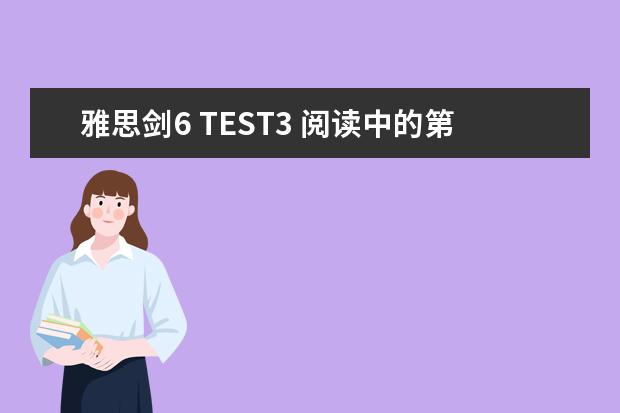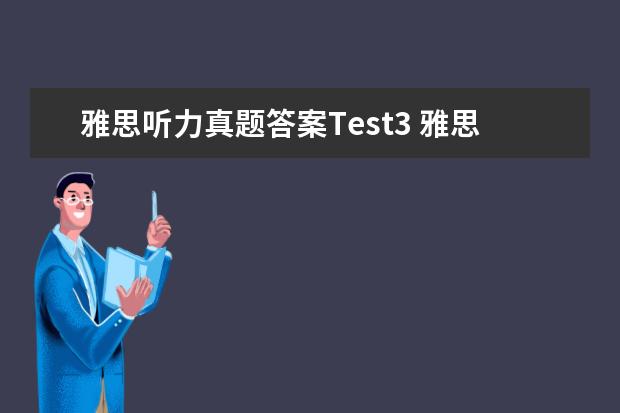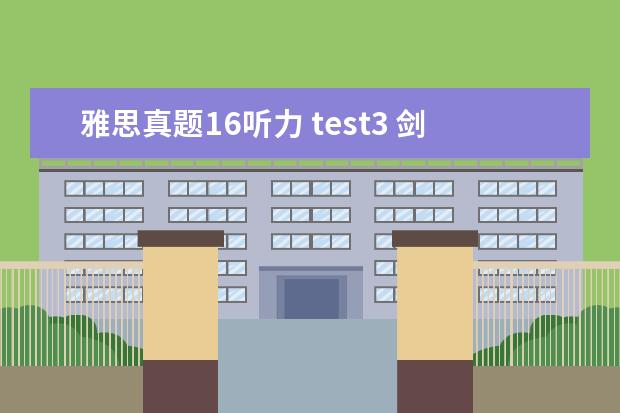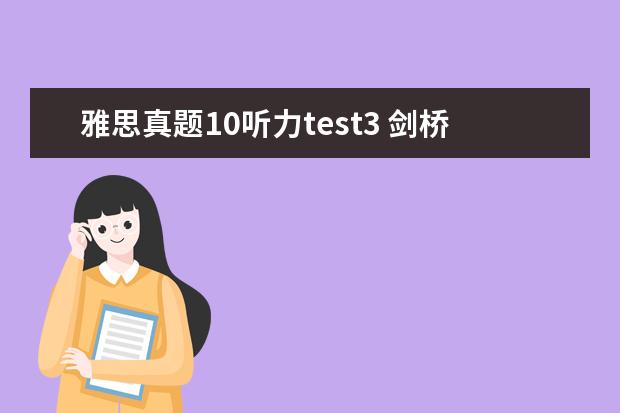剑桥雅思阅读真题解析 剑桥雅思10 test3 阅读 答案很多朋友对这方面很关心,雅思无忧整理了相关文章,供大家参考,一起来看一下吧!
本文目录一览:

2023年剑桥雅思阅读真题解析:Thomas Young
您好,我是专注留学考试规划和留学咨询的小钟老师。在追寻留学梦想的路上,选择合适的学校和专业,准备相关考试,都可能让人感到迷茫和困扰。作为一名有经验的留学顾问,我在此为您提供全方位的专业咨询和指导。欢迎随时提问!
对于雅思考生来说,剑桥雅思阅读题难不难?下面就和小钟老师一起来看看2023年剑桥雅思阅读真题解析:Thomas Young。
Thomas Young
The Last True Know-It-All
A Thomas Young (1773-1829) contributed 63 articles to the Encyclopedia Britannica, including 46 biographical entries (mostly on scientists and classicists) and substantial essays on "Bridge,” "Chromatics," "Egypt," "Languages" and "Tides". Was someone who could write authoritatively about so many subjects a polymath, a genius or a dilettante? In an ambitious new biography, Andrew Robinson argues that Young is a good contender for the epitaph "the last man who knew everything." Young has competition, however: The phrase, which Robinson takes for his title, also serves as the subtitle of two other recent biographies: Leonard Warren's 1998 life of paleontologist Joseph Leidy (1823-1891) and Paula Findlen's 2023 book on Athanasius Kircher (1602-1680), another polymath.
B Young, of course, did more than write encyclopedia entries. He presented his first paper to the Royal Society of London at the age of 20 and was elected a Fellow a week after his 21st birthday. In the paper, Young explained the process of accommodation in the human eye on how the eye focuses properly on objects at varying distances. Young hypothesized that this was achieved by changes in the shape of the lens. Young also theorized that light traveled in waves and he believed that, to account for the ability to see in color, there must be three receptors in the eye corresponding to the three "principal colors" to which the retina could respond: red, green, violet. All these hypothesis were subsequently proved to be correct.
C Later in his life, when he was in his forties, Young was instrumental in cracking the code that unlocked the unknown script on the Rosetta Stone, a tablet that was "found" in Egypt by the Napoleonic army in 1799. The stone contains text in three alphabets: Greek, something unrecognizable and Egyptian hieroglyphs. The unrecognizable script is now known as demotic and, as Young deduced, is related directly to hieroglyphic. His initial work on this appeared in his Britannica entry on Egypt. In another entry, he coined the term Indo-European to describe the family of languages spoken throughout most of Europe and northern India. These are the landmark achievements of a man who was a child prodigy and who, unlike many remarkable children, did not disappear into oblivion as an *.
D Born in 1773 in Somerset in England, Young lived from an early age with his maternal grandfather, eventually leaving to attend boarding school. He haddevoured books from the age of two, and through his own initiative he excelled at Latin, Greek, mathematics and natural philosophy. After leaving school, he was greatly encouraged by his mother's uncle, Richard Brockle*y, a physician and Fellow of the Royal Society. Following Brockle*y's lead, Young decided to pursue a career in medicine. He studied in London, following the medical circuit, and then moved on to more formal education in Edinburgh, Gottingen and Cambridge. After completing his medical training at the University of Cambridge in 1808, Young set up practice as a physician in London. He soon became a Fellow of the Royal College of Physicians and a few years later was appointed physician at St. George's Hospital.
E Young's skill as a physician, however, did not equal his skill as a scholar of natural philosophy or linguistics. Earlier, in 1801, he had been appointed to a professorship of natural philosophy at the Royal Institution, where he delivered as many as 60 lectures in a year. These were published in two volumes in 1807. In 1804 Young had become secretary to the Royal Society, a post he would hold until his death. His opinions were sought on civic and national matters, such as the introduction of gas lighting to London and methods of ship construction. From 1819 he was superintendent of the Nautical Almanac and secretary to the Board of Longitude. From 1824 to 1829 he was physician to and inspector of calculations for the Palladian Insurance Company. Between 1816 and 1825 he contributed his many and various entries to the Encyclopedia Britannica, and throughout his career he authored numerous books, essays and papers.
F Young is a perfect subject for a biography - perfect, but daunting. Few men contributed so much to so many technical fields. Robinson's aim is to introduce non-scientists to Young's work and life. He succeeds, providing clear expositions of the technical material (especially that on optics and Egyptian hieroglyphs). Some readers of this book will, like Robinson, find Young's accomplishments impressive; others will see him as some historians have - as a dilettante. Yet despite the rich material presented in this book, readers will not end up knowing Young personally. We catch glimpses of a playful Young, doodling Greek and Latin phrases in his notes on medical lectures and translating the verses that a young lady had written on the walls of a summerhouse into Greek elegiacs. Young was introduced into elite society, attended the theatre and learned to dance and play the flute. In addition, he was an accomplished horseman. However, his personal life looks pale next to his vibrant career and studies.
G Young married Eliza Maxwell in 1804, and according to Robinson, "their marriage was a happy one and she appreciated his work." Almost all we know about her is that she sustained her hu*and through some rancorous disputes about optics and that she worried about money when his medical career was slow to take off. Very little evidence survives about the complexities of Young's relationships with his mother and father. Robinson does not credit them, or anyone else, with shaping Young's extraordinary mind. Despite the lack of details concerning Young's relationships, however, anyone interested in what it means to be a genius should read this book.
Questions 1-7
Do the following statements agree with the information given in Reading Passage 1?
In boxes 1-6 on your answer sheet, write
TRUE if the statement is true
FALSE if the statement is false
NOT GIVEN if the information is not given in the passage
1 “The last man who knew everything” has also been claimed to other people.
2 All Young’s articles were published in Encyclopedia Britannica.
3 Like others, Young wasn't so brilliant when grew up.
4 Young's talents as a doctor are surpassing his other skills.
5 Young's advice was sought by people responsible for local and national issues.
6 Young was interested in various social pastimes.
7 Young suffered from a disease in his later years.
Questions 8-13
Answer the questions below.
Choose NO MORE THAN THREE WORDS AND/OR A NUMBER from the passage for each answer.
8 How many life stories did Young write for Encyclopedia Britannica?
9 What aspect of scientific research did Young do in his first academic paper?
10 What name did Young introduce to refer to a group of languages?
11 Who inspired Young to start the medical studies?
12 Where did Young get a teaching position?
13 What contribution did Young make to London?
文章题目:
Thomas Young—The Last True Know-it All
托马斯·杨——最后一个无所不知的人
篇章结构
体裁人物传记
题目托马斯·杨——最后一个无所不知的人
结构A段:托马斯·杨对百科全书的主要成就
B段:托马斯年轻时的主要成就
C段:托马斯晚年的主要成就
D段:托马斯童年的生活背景及成长经历
E段:托马斯作为自然哲学学者取得的成就
F段: 托马斯在其他领域的成就
G段:托马斯的感情生活
试题分析
Question 1-7
题目类型:True / false /not given
题号定位词文中对应点题目解析
1Other peopleA段第四句“Young has competition, however: The phrase, which Robinson takes for his title, also serves as the subtitle of two other recent biographies: Leonard Warren's 1998 life of paleontologist Joseph Leidy (1823-1891) and Paula Findlen's 2023 book on Athanasius Kircher (1602-1680), another polymath.”该句中明确给出了Young还有其他的竞争者,他们的传记中也同样拥有这样的小标题,分别是Leonard Warren写的关于Joseph Leidy的传记,以及 Paula Findlen's写的关于Athanasius Kircher的传记。
因此,本题答案为True
2all, articlesB段第一、二句B段第一句 “Young, of course, did more than write encyclopedia entries.”明确表示Young所做的远不仅仅是编辑大英百科全书的词条,因此并不是所有的都在百科全书。而在本段第二句中,作者指出,Young在20岁的时候将自己的第一篇论文自荐给伦敦皇家学会,并在一年后成为该学会的会员: He presented his first paper to the Royal Society of London at the age of 20 and was elected a Fellow a week after his 21st birthday。Paper与article为近意思。显然,题干与原文含义相反。
因此,本题答案为False
3likeC段最后一句C段整体是在介绍Young晚年的主要成就,即Young长大后的成就。此外,在C段最后一句中,作者明确指出Young和其他的孩子不同的一点在于,Young并没有像其他那些年少成名而后来江郎才尽的孩子一样,他后来同样取得了非凡的成就: These are the landmark achievements of a man who was a child prodigy and who, unlike many remarkable children, did not disappear into oblivion as an *.句中的unlike为like的反义词,显然题干与原文含义相反。
因此,本题答案为False
4surpassingD段第四、七句D段介绍了Young的成长背景和经历,同时体现出其涉猎范围较为广泛。其中第四句中提到Young决定学医,并且在后面的介绍中指出Young还参加戏剧演出,学习跳舞和吹笛子: He then broke with his Quaker upbringing by attending the theater and learning to dance and play the flute. In addition, he was an accomplished horseman.而在第七句中作者指出Young还是一名杰出的马术师。但是并未指出Young在哪个方面的造诣更高,更有天赋。Surpassing这个概念并没有在文中体现。
因此,本题答案为Not Given
5soughtE段第四句“ His opinions were sought on civic and national matters”,文中表明Young的很多观点关注人民和国家事务。题干与原文含义相同。
因此,本题答案为True
6Interested in, social pastimeF段第七句“We catch glimpses of a playful Young, doodling Greek and Latin phrases in his notes on medical lectures and translating the verses that a young lady had written on the walls of a summerhouse into Greek elegiacs.”文中指出,通过Young的医学演讲中乱写的希腊字母和拉丁短语以及将一位年轻女性写在凉亭上的诗歌翻译成希腊挽歌便能看出他的幽默。显然,Young对于这样的社交娱乐是感兴趣的。题干和原文相符合。
因此,本题答案为True
7disease, later yearsC段第一句,G段第一句C段第一句给出了“later in his life,”但是本段近讲述了Young晚年在学术方面的成就;G段给出了Young的婚后生活,以及Robinson在书中并未提及Young与父母间的关系。但无论哪一个点都没有提及其晚年饱受某种疾病之苦。
因此,本题答案为Not Given
题目类型:Short-answer question
8life storiesA段第一句“Thomas Young (1773-1829) contributed 63 articles to the Encyclopedia Britannica, including 46 biographical entries (mostly on scientists and classicists)…”该剧中的“biographical entries”指传记词条,与题干中的life stories表示相同涵义。
因此,本题答案为46
9first academic paperB段第三句“In the paper, on how the eye focuses properly on objects at varying distances, Young hypothesized that deformation of the crystalline lens accomplished the accommodation.”B段段首表明,Young将自己的第一篇论文自荐给了伦敦皇家学会学会。因此本段讨论的是其第一篇论文。而本段第三句指出,在这篇论文中,Young主要讨论了人类眼球的调节机制
因此,本题答案为humaneye或human eye accommodation
10a group of languagesC段第五句“In another entry, he coined the term Indo-European to describe the family of languages spoken throughout most of Europe and northern India.”该句指出,Young创造了术语 Indo-European来描述在欧洲大部分地区以及北印度使用的语言。
因此,本题答案为Indo-European
11inspire, medical studiesD段第四句D段前面介绍了Young童年时期的生活背景。本段第四句中则指出:“Following Brockle*y's lead, Young decided to pursue a career in medicine.”。显然,正是因为 Richard Brockle*y的引导,Young才决定在医学方面有所建树。
因此,本题答案为 Richard Brockle*y
12teaching positionE段第二句“ Earlier, in 1801, he had been appointed to a professorship of natural philosophy at the Royal Institution”,题干中的teaching position与E段第二句中的professorship均表示“教师职位”,该句明确指出,Young作为自然哲学的教授,受聘于英国科学研究所。
因此,本题答案为 Royal Institution
13LondonE段第五句“His opinions were sought on civic and national matters, such as the introduction of gas lighting to London and methods of ship construction.”E段主要介绍了Young作为自然哲学学者取得的成就。而第五句则列举了Young的两个成就,其对于伦敦的所做出的成就在于煤气照明的引入。
因此,本题答案为gas lighting
A我们该怎样理解托马斯·杨(1773-1829)?他是《大不列颠百科全书》中63篇文章的作者,其中包括46篇传记(大部分都是关于科学家和古典学者),和大量关于“桥” “色彩论” “埃及” “语吉” “潮汐”等的论文。一个能够写出这样多有权威性文章的人应该算是一个博学者? 一个天才?还是一个业余兴趣广泛的人呢?在一篇关于他的比较激进的传记中,Andrew Robinson 认为托马斯杨是-位强有力的竞争者能够配得这样的墓志铭“是最后一个知道任何事的人”。但是杨也要面对竞争:因为这样的传记标题Robinson不仅给了他,也作为副标题给了有关另两位学者的传记:Lenard Warren 1998年著的《古生物学家Joseph Leipy的一生》(1823-1891)以及Paula Findlen 2023年著的关于另一位博学者Athanasius Kircher(1602-1680)的传记。
B当然杨的贡献远不止写了很多百科全书上的文章,他在20岁的时候将自己的第一篇论文自荐给伦敦皇家学会,并在他的21岁生日后被评为一周科学人物,杨在该篇论文中解释了人类眼睛的调节机制一一关于眼睛如何通过不同的距离聚焦在物体上。在后面的文章中,他更加全面地探讨了这个问题,类似牛顿,他在自己身上进行了可怕的实验用以获得相关的证据,他还得出这样的理论:光是通过“以太”分子的振动,以波的形式进行传递的,而“以太”是一种假想物质,其存在还存在争议性。他还认为为了能看见颜色,必须要有3个感应器对“三原色”进行感应,而这三种视网膜对其产生感应的颜色就是红,黄,蓝二种颜色。
C在他人生的晚些时候,也就是40多岁的时候,杨试图破解锁在罗塞塔石碑里的未知文字密码,这个石碑是在1799年在埃及被拿破仑的军队发现的,并且从1802年起就在英国博物馆进行展出。该石碑上包含了 3种不同的字母:希腊语,不可辨识的文字以及埃及的象形文字。这种不可辨识的文字现在被认为是正如杨所推断的是很普通的,是和象形文字直接相关的。他最初有关这方面的工作首次出现在他在《大不列颠百科全书》中编纂的词条。在另一个条目中,他创造了术语“Indo-European”来描述在欧洲大部分地区以及北印度使用的语言。这些都是这是这位从小就展露科学天赋并且不像很多孩子后来江郎才尽的科学家获得的里程碑式的成就。
D托马斯·杨出生在英国萨默塞特郡一个虔诚的教友会教徒家庭,从小和他的外公一起长大,最后去了寄宿学校。他两岁的时候就博览群书,并且自学熟练掌握了拉丁语,希腊语,数学以及哲学,在很大程度上他受到了舅舅Richard Brockle*y的鼓励,他的舅舅也是英国皇家学会的一位内科医生。在Brockle*y的引导下,杨决定要在医学方而有所建树,他曾先后在伦敦大学、爱丁堡大学和格丁根大学学习医学,多亏了Brockle*y的引荐,杨进入了英国皇家学会,他最后也打破了从小在教友会的教育,他参加戏剧演出,学习跳舞和吹笛子,此外,他还是一位杰出的马术师。在1808年结束在剑桥大学的医学学习后,杨在伦敦开了一家诊所,很快他就成为皇家内科医生学会的一员,并且几年后成为圣乔治医院的一名内科医生。
E杨作为内科医生的医术却赶不上他作为自然哲学学者或是语言学家取得的成就,早在1801年,他已经被任命为英国皇家学会的教授,他每年要在那里举办60场的讲座。这些讲座在1807年以两本书的形式进行出版。1804年杨就已经成为英国朵家学会的秘书,而他获此殊荣直至去世。他的很多观点关注人民和国家事务,比如说在伦敦引进煤气照明和造船方法。从1819年起,他就是航海天文年历的主要负责人,也是Board of Longitude的秘书。从1824年到1829年,他担任Palladian 保险公司的精算师和内科医生。在1816年和1825年间,他为《大不列颠百科全书》编纂了许多词条,而且穷其一生著作,论文无数。
F我们通过杨在医学课上胡乱写的希腊字母和拉丁文短语以及他将一位年轻的女士写在避暑山庄墙上的诗句翻译成挽歌可以看出他的幽默,但是他的个人生活也因为自己对工作和研究的全情投入而略显苍白。
G他在1804年和Eliza Maxwell结婚,据Robinson所述“他们的婚姻是幸福的,因为他的夫人欣赏他的工作”。我们对于他夫人的了解仅限于她在她丈夫备受一些关于眼睛的理论方面争议的时候总是坚定地支持他,并且当他的医学生涯开始慢慢起飞的时候,她开始有些担心钱的问题。值得一提的是,杨没有被保护的人,他都是和自己的导师进行互动一一先是他的外公,后是Brockle*y一一还有先于他过失的一些伟人(其中很多是很著名的如牛顿,杨最早在17岁读了他写的书)。但是关于杨和他母亲以及父亲的关系的记述却鲜力人知,Robinson在说到杨的非凡的头脑时也并没有将其归功于他的父母,或许很难有这样的巧合:过去的天才都是由于卓越的父母教育造就的。
希望以上的答复能对您的留学申请有所帮助。如果您有任何更详细的问题或需要进一步的协助,我强烈推荐您访问我们的留学官方网站
,在那里您可以找到更多专业的留学考试规划和留学资料以及*的咨询服务。祝您留学申请顺利!
剑桥雅思10 test3 阅读 答案
答案解析:
1. 选ii。定位到第二段第一句话:Touri* in the mass form as we know it today is a distinctly twentieth-century phenomenon. 表明就我们所知,广义的旅游业是一个二十世纪的现象。选项中的mass touri*与原文中的touri* in the mass form是同义替换。
2. 选i。定位到第三段第一句话:Touri* today has grown significantly in both economic and social importance. 即目前旅游业对经济及社会都非常重要。选项中的significance替换原文的importance。
3. 选v。定位到第四段第一句话:However, the major problems of the travel and touri* industry that have hidden or obscured its economic impact are the diversity and fragmentation of the industry itself. 意思是旅游业的主要问题是这个产业本身的多样性和分散性,这使得其经济影响变得不那么明显。选项中的difficulty,effects分别替换原文的problems和impact。
4. 选vii。定位到第五段第一句话:Once the exclusive province of the wealthy, travel and touri* have become an institutionalised way of life for most of the population. 表明旅游业曾经是富人们的特权,而现在已经变成大多数人们习以为常的一种生活方式了。选项中的world,impact替换原文的most of the population, institutionalised。
Questions 5-10 判断题
5. The largest employment figures in the world are found in the travel and touri* industry.
6. Touri* contributes over six per cent of the Australian gross national product.
7. Touri* has a social impact because it promotes recreation.
8. Two main features of the travel and touri* industry make its economic significance difficult to ascertain.
9. Visitor spending is always greater than the spending of residents in tourist areas.
10. It is easy to show statistically how touri* affects individual economies.
答案解析:
5. 选TRUE。定位到第三段第三句话: According to the World Travel and Touri* Council (1992), ‘Travel and touri* is the largest industry in the world on virtually any economic measure including value-added capital investment, employment and tax contributions’。意思是旅游业是全世界最大的行业,不管是用哪种经济学估算,其中包括资本增值投资,就业及税收贡献。题目中的figures替换原文measure。
6. 原文没有提到Australian gross national product这个概念,所以选择NG。
7. 原文没有提到recreation这个概念,所以选择NG。
8. 选TRUE。定位到第四段第一句话:However, the major problems of the travel and touri* industry that have hidden, or obscured its economic impact, are the diversity and fragmentation of the industry itself. 意思是旅游业的主要问题是这个产业本身的多样性和分散性,这使得其经济影响变得不那么明显。题目中的two main features指代原文的diversity and fragmentation。
9. 原文没有提到visitor spending 和residents’ spending的比较关系,所以选择NG。
10. 选FALSE。定位到第四段倒数第二句,原文表明this problem has made it difficult ...to estimate the contribution it makes, 即估算旅游业对经济的贡献很困难,所以选FALSE。
Questions 11-13 句子填空题
11. In Greece, touri* is the most important ________.
12. The travel and touri* industry in Jamaica is the major ______ .
13. The problems associated with measuring international touri* are often reflected in the measurement of _______ .
答案解析:
11. 填source of income/home。定位到最后一段的第三句: For example, touri* is the major source of income in Bermuda, Greece, Italy, Spain, Switzerland, and most Caribbean countries. 说明旅游业在以下国家都是收入的主要来源,题目中的most important替换原文的major。
12. 填employer。定位到最后一段的第四句: In addition, Hawkins and Ritchie, quoting from data published by the American Express Company, suggesting that the travel and touri* industry is the number one ranked employer in the Bahamas, Brazil, Canada, France, (the former) West Germany, Hong Kong, Italy, Jamaica, Japan, Singapore. 说明旅游业在一下国家是最需要聘用雇员的行业,题目中的major替换原文的number one ranked。
13. 填domestic industry。定位到最后一段的最后一句: In many cases, similar difficulties arise when attempts are made to measure domestic touri*. 说明测量估算国内旅游业非常困难,题目中的measurement, problems替换原文的measure, difficulties。
雅思阅读真题答案:龙涎香Ambergris
为了帮助大家备考雅思的阅读,参考更多真题,下面我给大家带来雅思阅读真题答案:龙涎香 Ambergris,望喜欢!
雅思阅读真题答案:龙涎香 Ambergris
文章 标题 Ambergris 龙涎香 文章大意 关于ambergris龙涎香和amber琥珀
第一段说 ambergris这个东西很久以前就有了,然后说ambergris的用途有 for medicine, spice,用来*perfume 什么的等等(有题,matching) 然后说但是人们不知道它是从哪里来的,再就是说在古代it worth in weight in gold,当然是贵了。
第二段说 以前人们一直把ambergris和amber当作一种东西。但是有个叫Dick的作者 写了一本书 讲了这两个东西的区别(有题,matching)说ambergris 通常发现在海面或者shore,但是仍然不知道是从哪里来的。 Amber是一种什么东西,与松树pine有关, 然后说了amber的一些特性 hard,transparent, 等等,用来做装饰品, 头饰什么的, 同样 very costly。(有题,matching)
第三段说ambergris是与sperm whale的intestine肠子里的消化digest 某种东西有关。以为intestine会有题,结果没有,提到了马可波罗,好像与这个发现有关(没题,当笑话好了)
第四段就是具体describe ambergris的产生过程了。(summary 题)大意是,sperm whale吃一种东西 叫 beaks of squalid, 肠子就有助消化,但是不能完全消化,就转化成了另一种东西,应该是体内的垃圾。这种垃圾是soft的,会被sperm whale 呕吐出来 be vomited up。 然后这种东西遇到空气就会变硬 harden, 于是就形成了 ambergris了,也解释了为什么ambergris总在海面和shore被发现。
第五段 说人们为了获得ambergris而捕杀sperm whale 导致了濒临灭绝。给了一个数据 说in 20th century, 90% ambergris was made in the processing of killing sperm whale。(有题, TFNG)ambergris was still the most expensive product in the whole body of sperm whale,大意是这样的。 于是人们就开始采取 措施 保护sperm whale, 在工业生产中采用了很多ambergris的替代品,例如香水*业中就用了某种东西,代替了ambergris。
第六段 说 sperm whale的数量会有recover的那么一天,没题。 题目类型 Matching
Summary填空
T/F/NG 参考答案 Matching
A only ambergris
B only amber
C both
D neither
·very expensive C
·use in medicine A
·use as currency D
·refers to in a Book written by Dick _x C
·could be seen through B Summary填空
ambergris的形成步骤龙涎香是抹香鲸的呼吸道分泌物
·sperm whale 吃下去 beaks of squalid,
·_x be vomited up,
·hardens when exposure on air T/F/NG
·20th century most ambergris was made in the processing of killing of sperm whale。 T
·Ambergris’s cost increased recently。 NG
·ambergris still remains in the perfume making。 F
·关于保护鲸鱼的 F
两招教你突破雅思阅读判断题三大难点
但凡接触过雅思真题或曾经亲历雅思考场的考生大多对TRUE/FALSE/NOT GIVEN (另一种写法为YES/NO/NOT GIVEN)的题型颇有印象,原因有二:
一是此题型在考场上出现频率极高,仅以2021年为例,全年48场雅思考试场场都有此题型的身影;
二是此题型虽然备选项只有三个,答题命中率在理论上比四选一的单选题还高,却颇不容易全盘做对。
下面笔者将带领读者一起来仔细认识与分析雅思阅读判定题的概念、套路、难点和解决之道。
雅思判断题的定义
理解判断题的第一步是理解TRUE/FALSE/NOT GIVEN的定义,逐一分析如下:
TRUE (YES)的定义为the statement agrees with the information/the views (claims) of the writer,即“此说法与原文信息/作者的观点或主张相符”。这里的重点信息在于agree with的概念,此选项并非要求题干与原文的内容一模一样,而只要符合原文信息即可。
举个例子说明,原文 句子 说“这个女生长得很漂亮”,那么题干说“这个女生长得很好看”或“这小姑娘长相真是还可以”都是与原文信息相符,此时考生要选TRUE (YES)。
FALSE (NO)的定义为the statement contradicts the information,即“如果此说法与原文信息相矛盾和抵触”。这里的重点信息在于contradict一词:contra是“相反”“相违背”的意思,dict则是“陈述”“说明”的意思。也就是说,应选FALSE的题干与原文信息是相矛盾、相违背、相抵触的,原文中给出的已知信息可以直接或经过合理推理否定掉题干的内容。
比如,原文说“这个女生长得很漂亮”,那题干说“这姑娘长得真丑”就是错误的,或者题干说“这位小娘子貌似无颜”,也是错误的。
NOT GIVEN的定义为there is no information on this/it is impossible to say what the writer thinks about this,即“此说法在原文中找不到”或“没法知道作者对此是怎么看的”。许多考生都将此视为最麻烦的一个选项,因为如果不能把整篇文章都看完并且看懂,每个NOT GIVEN的选项都是在惴惴不安的心情中写下的。
NOT GIVEN的情况其实可以分为以下两种:
① 原文中完全没有提及题干所说的相关内容,不过这种完全无中生有的题目比较罕见;
② 原文中提到的相关信息与题干内容不属于同一个范围或性质。
比如题干说“这个女生长得很好看”,而原文中提到的与“此女生”有关的内容是“这个女生是个善良的好孩子,这种情况下,长相和个性虽然都是在描述这个女生,但两者既不一致也不矛盾,此时考生应选NOT GIVEN。
雅思判定题出题套路
判断题的逻辑其实不难理解,但许多考生依然烦恼:看定义貌似懂了,一到做题的时候还是纠结不已。这跟考生的单词量、语法基础、长难句分析能力和思维习惯等方面都有关系。不过 总结 起来,每个选项的出题还是有一定套路的。
以下笔者来一一详述。
1. TRUE (YES)的出题套路
① 直接说对
“直接说对”指的是题干的意思与原文定位到的句子只是简单的同义替换,考生能直接判断题干所说与原文信息相符。
这样的题目其实是在考查考生的单词量大小,因为题干会使用不同的词汇对原文进行同义替换。
比如题干说long-term medical complaints,原文说chronic illnesses,考生就不但要认识long-term与chronic是同义替换关系,而且要明白medical与complaint组合在一起并不是“医疗投诉、医疗纠纷”这类意思,而是作为一个词组表示“疾病”。
备考此类题目的最好策略就是补充单词和词组。而备考的最好材料莫过于《剑桥雅思考试全真试题集》(以下简称《剑4》《剑5》等)系列。考生多看几篇以往的真题就会发现,有许多词汇和词组会高频地出现在不同题材的文章里,因此仔细研读真题文章中的生词能有效帮助解决词汇的问题。
② 间接说对
“间接说对”指的是有些题干需要根据原文某句话或几句话进行简单推理或综合理解才能判断其是TRUE (YES)。
应对此种情况,考生在读文章时请务必耐心一些,在定位到某句话而不能充分判断时,需根据情况补充上句话的背景信息或追加下句话的进一步信息,进而得出更准确的结论。
以下面这个真题为例。
例1:The survey concluded that one-fifth or 20% of the household transport requirement as outside the local area. (《剑七》Test 2 Passage 3第34题)
原文:Interesting facts regarding transport were found: 95% was on foot; 80% was within the locality; and 70% was related to the collection of water and firewood and travelling to grinding mills.
解析:在定位到的原文句子里,考生虽然不能直接找到题干中的20%,但从原文中可以看出“本地范围内占80%”(80% was within the locality),就可以推断出“本地范围外有20%”,由此得出本题应选TRUE。
③ 复杂同义表述
“复杂同义表述”指的是题干与定位到的原文句子同义替换更多更复杂,原文的表述方式也更曲折迂回,语序不符合中文读者理解习惯,考生有可能受自身语言能力所限看不出来题干与原文是同义替换。
针对此种情况,考生可以在考场上先跳过此题,集中精力解决 其它 更有把握的题目,以保证整体得分;也可以在平时备考中注意练习精读分析能力,让自己见多识广,看到多长的句子都心中不怵,能从容应对。
例2:Nineteenth-century studies of the nature of genius failed to take into account the uniqueness of the person’s upbringing. (《剑8》Test 3 Passage 2第19题)
原文:However, the difficulty with the evidence produced by these studies, fascinating as they are in collecting together anecdotes and apparent similarities and exceptions, is that they are not what we would today call norm-referenced. In other words, when, for instance, information is collated about early illnesses, methods of upbringing, schooling, etc., we must also take into account information from other historical sources about how common or exceptional these were at the time.
译文:但是,虽然(19世纪的)这些研究在收集汇总天才们的人生轶事以及他们之间显著的相似和与众不同这些方面颇为引人入胜,然而使用这些证据的困难之处在于,它们并不是我们今天所说的“常模参照”研究。换句话说,例如当我们收集关于早期疾病、 儿童 抚养 方法 、学校 教育 等信息时,我们必须也同时参考来自其他历史记载中的相关信息,考察这些情况在当时究竟是常见还是少见的。
解析:本题的题干是说“19世纪里对天才本质的研究没能考虑到此人养育方式的独特与否”,而从定位到的原文的译文可知,早期的研究确实没有考虑这些儿童养育方法等问题,由此本题应选TRUE。
这是一个利用长难句来考查考生阅读理解能力的典型例子,难度同时在于单词和耐心两处,很多考生都觉得,连读中文译文都有点不耐烦,要理解包含若干陌生单词的英语长句就更难了。
对此,考生最好的应对之道就是培养耐心,认真看。平时认真分析精读长难句,熟悉长难句的句式结构,在考场上就更能轻松地应对。
2. FALSE (NO)的出题套路
① 直接、明显的矛盾和抵触
有的题干与定位到的原文是明显的矛盾抵触关系,此时考生应选FALSE/NO选项。请看下面这个例子。
例3:Current thinking on humour has largely ignored Aristotle’s view on the subject. (《剑5》Test 2 Passage 2第17题)
原文:But modern humour theorists have settled on some version of Aristotle’s belief that jokes are based on a reaction to or resolution of incongruity, when the punchline is either a nonsense or, though appearing silly, has a clever second meaning.
解析:虽然这道题定位到的原文句子生词很多,句子很长,但是对于“Aristotle’s belief that …”后面的东西考生通通不用看。考生需要弄清楚的是,现在对幽默的研究有没有忽略亚里士多德(Aristotle)的观点,有这个原文中的settle on (选定)就可以直接判断出,题干与原文是相互矛盾与抵触的。
② 间接不明显的矛盾和抵触
这种出题思路需要考生根据定位到的原文句子进行推断才能发现题干与原文的矛盾之处。这一题型专门用于对付那些想偷个小懒只找词汇的同义替换而不管整个句子到底在说什么的考生。请牢记:句子永远大于单独的词汇,不能只看单词而不管句子意思或上下文中的衔接关系。来看一个经典例子。
例4:The 1993 Sydney survey involved 289 patients who visited alternative therapists for acupuncture treatment. (《剑4》Test 2 Passage 2第22题)
原文:In 1993, Dr. Laver and his colleagues published a survey of 289 Sydney people who attended eight alternative therapists’ practices in Sydney. These practices offered a wide range of alternative therapies from 25 therapists.
解析:很多考生定位到上述原文句子之后,因为在原文句子中没有找到acupuncture (针灸疗法)这个不认识的词而选了NOT GIVEN选项。然而这里的两句话所给出的内容其实是可以否定掉题干的。从原文的意思可知,1993年悉尼调查里确实有289个病人,这些病人接受了八家诊所由25位治疗师提供的a wide range of (一系列)的治疗。换言之,这289位病人接受了各种治疗,由此可以反推知道他们接受的一定不是任何单一的治疗,而题干则说这289位病人接受的都是针灸疗法这一种,与原文产生矛盾,应选FALSE。
3. NOT GIVEN的出题套路
① 原文和题干的描述性质不同
这种出题思路对考生的 英语阅读 和理解水平要求都较高,因此按照这种思路出的题往往会让考生感到难以判断。举例说明,冷水与热水是矛盾的,因为它们都在描述“水的温度”这个属性;然而冷水与茶水则既不能说一致,也不能说彼此矛盾:这两者一个在说水的温度,另一个则说水的状态,此时考生应该选择NOT GIVEN。请看下面一个例子。
例5:Plato believed humour to be a sign of above-average intelligence. (《剑5》Test 2 Passage 2第15题)
原文:Plato expressed the idea that humour is simply a delighted feeling of superiority over others.
解析:对比题干与定位到的原文,两者确实都是在说柏拉图对“幽默是什么”的表述,但原文说“幽默是感觉”,题干说“幽默是智商”,感觉和智商的性质不同,但并不彼此矛盾,此时考生应选NOT GIVEN。
② 把观点当事实,或把事实当观点
事实是客观的而观点是主观的,这二者既不一致也不矛盾。“某个人对于某件事怎么想”既不能等同于也不能否定掉这件事的客观定性。同理,客观定了性的某件事未必就意味着特定的某个人也是这么想。考生应该将事实与观点区分开。请看下面这个例子。
例6:The Lumiere Brothers’ film about the train was one of the greatest films ever made. (《剑6》Test 3 Passage 1第7题)
原文:One of the Lumiere Brothers’ earliest films was a 30-second piece which showed a section of a railway platform flooded with sunshine. A train appears and heads straight for the camera. And that is all that happens. Yet the Russian director Andrei Tarkovsky, one of the greatest of all film artists, described the film as a ‘work of genius.’
解析:对比原文和题干,考生应该明白,原文说“最伟大的导演之一安德烈·塔可夫斯基(Andrei Tarkovsky)认为这部电影是天才之作”既不能等同于题干的“这部电影确实是最伟大的作品之一”,也无法否定掉题干的说法,因此此题只能选NOT GIVEN这项。
③ 把原文里出现的两个没有进行比较的内容放在一起比较
这种出题思路主要针对的是某些考生在考试中出现疲惫、马虎的心理,只单纯在原文中找到几个题干里的关键词就匆忙认为都被提及或表述一致,最终因为忽略了整句的意思而导致错选。
例7:Early peoples found it easier to count by using their fingers rather than a group of pebbles. (《剑6》Test 2 Passage 3第40题)
原文:Counting is not directly related to the formation of a number concept because it is possible to count by matching the items being counted against a group of pebbles, grains of corn, or the counter’s fingers.
解析:此题的题干是将用手指数数与用石头数数进行了对比,然而在定位到的原文中却没有进行此种比较。这种“没有比较的比较”算是比较常见的NOT GIVEN选项的出题套路。
难点与解决之道
判断题的难点主要包括以下几点:
考生单词量不足,导致不能正确理解题干和原文
单词量不够并不仅仅是考生在应对判断题时所面临的问题,它是一个在所有英语考试中都令考生头疼的一个根本性问题。积累单词没有什么捷径,唯有少量多次、稳步积累、不断复习、巩固强化。一个人无论 记忆力 多么超乎常人,也不大可能日背千词、过目不忘。而制订合理的背单词计划,考生哪怕每天只补充10~20个单词,只要坚持下去,日积月累也能收获回报。
考生对单词意思了解不足,导致理解错误
部分考生在背诵单词时只记中文释义,不结合例句来理解,这样即使强记下了单词意思,却往往会导致对单词的意思了解不足。
例如,contemporary一词的释义是“当代的,现代的”,但要注意:不是只有我们的当下才能称为“当代”,任何一个给定时间点都有自己的“当代”,比如,与李白contemporary的人有杜甫,与莎士比亚contemporary的人有伊丽莎白一世女王。如果看到这个单词就将它等同于modern来理解,就有可能因为误解而做出错误选择。
如何避免出现这样的情况呢?
最好的办法莫过于对剑桥雅思真题里的文章进行仔细分析和精读,在语境下真正弄懂单词、词组和固定搭配的用法,储备真正掌握了的词汇来应对考试。
考生读题马虎,过度推理,导致误解了题干或原文句子
这个问题其实最不应该发生在考场上,却往往是考生容易“大意失荆州”之处。举个笔者的学生曾经产生过误解的例子:“Archaeology is a more demanding field of study than anthropology.” 这个题干原本表达的意思是“考古学是一门比人类学更加艰深的研究领域”,笔者的学生却曾将它理解成“考古学比人类学需要做更多的田野调查”,出现这个问题的原因是考生将field与study之间的那个of看漏了。
这样的问题该如何克服?
考生可以通过加大平时的英文阅读量来解决,熟能生巧,读得多了就能准确而快速地理解所读英文的真正意思。
面对阅读中的生词,我们一定要查字典么?
很多学生在做雅思阅读的时候,遇到生单词会习惯性地立马去查字典,总觉得不查就没有办法做题。可考试中我们可是查不了单词的,所以今天我来讲讲猜单词的方法。
通过词的前后缀 (前缀表意,后缀表词性)
E.g:Internet—net是“网”,inter-是有互通,互联的意思,所以Internet是“互联网”;
那么national“国家的”变成international就是“国际的”;
City“城市”变成“inter-city”就是“城际的”。
通过符号来看意思--冒号,括号和破折号表解释说明
E.g:Video recordings avoid these problems to a large extent, but even they have limitations (the camera cannot be everywhere), and …(C4T3P3)
这句话中学生若不明白limitation的含义,完全可以通过括号里面的意思猜到limitation是贬义词,就是不好的,对于理解不理解的到是“限制”的意思对做题没有影响,题目照样能做对。
Typically, children do not end up on the streets due to a single cause, but to a combination of factors: a dearth of adequately funded schools, the demand for income at home, family breakdown and violence.(C4T3P1)
冒号后面即为解释说明什么是a combination of factors,或者简单来说就是有哪些factors,因题目问的是孩子们为什么会沦落街头,那在冒号后面就是作为答题的重要依据了。
Chimpanzees have a “play-face”—a gaping expression accompanied by a panting “ah,ah” noise.(C5T2P2)
破折号在这里解释说明了什么是play-face,简单解释也就是一种expression,那么如果学生能够定位准确,不能理解什么是play-face,对答案的判断也没有任何影响。
特别注意:很多学生分不清连词符和破折号。连词符是短的,并且和单词之间没有空格;儿破折号是长的,且和前后单词有空格。
其实符号在雅思阅读中用来表解释说明的现象非常普遍,只是很多学生在做题的时候并没有意识到出题人的这个考察点,因为非常的细微,一般语法能力还不错的学生其实在不经意间已经用了上述猜单词方法,只是自己没有意识到而已。所以对于基础薄弱的学生,要重点提出,加以总结,让其能够在阅读中应用。
同位语、插入语表解释说明
E.g:Graeme Ritchie, a computational linguist in Edinburgh, studies the linguistic structure of jokes in order to understand not only humor but language understanding and reasoning in machines. (C5T2P2)
本句提到Graeme Ritchie这个人,这个人是谁呢,后面解释说他是a computational linguist in Edinburgh,结合我们所说第一点,不认识computational,但computer应该知道,-al结尾形容词,linguist以-ist结尾,表“...人/家”,后面一个in+大写,猜也知道是地名,所以大概能猜到这个人是电脑方面的一个什么专家。如果能判断到这一点,对后面的判断18题会很有帮助。
特别注意:同位语注意是位置的“位”,也就是说和被解释词在句中的位置是相同的,这类用法多见于解释专有名词(比如人名,地名),这对于做 配对 题和一些细节判断题很有帮助;其次要注意的是有时候插入语两边的逗号也会变成两个破折号,其用意相同,完全可以当做两个逗号看待。
表“包含、包括、举例”的
E.g:World science is dominated today by a *all number of languages, including Japanese, German and French…(C5T2P3)
这个例子比较简单,但是如果真的不认识languages,完全可以通过Japanese, German and French来猜测其意思,一定是上一级词汇,所以意思是“语言”。也就是说看到include,involve,contain,for example,for instance,such as等表“包含、例如”的词时候,若能认识这些词后面一到两个词的意思,会帮助猜测这些词之前的单词意思,一定是这一到两个词的上义词。
定语从句
E.g:And they are known to have used wooded pulleys, which could have been made strong enough to bear the weight of massive blocks of stone.(C7T4P1)
His talent and devotion to the subject were perceived by his teacher, Thomas Hall, who encouraged him to attend a series of lectures given by the eminent scientist Michael Faraday at the Royal Institution. (C9T1P1)
定语从句本身是修饰作用,但这种句子的修饰其实是在帮助我们理解一个复杂词汇,把不懂得具象化。比如第一句的wooden pulleys不知道,后面大致能明白说是它可以承受巨大重量,那只要理解这个wooden pulleys是个可以承重的东西即可;同理,第二个句子不仅有定语从句,还用到了方法3,Thomas Hall是谁,是his teacher,他怎么了,他鼓励他学生去参加Michael Faraday的课,进一步解释说明了Thomas Hall的身份。
知道一些单词的熟词僻义--通过语境判断意思
这个方法是给英语词汇还不错的学生的,很多学生会有一个困扰是虽然背了很多单词,但好像还是不能看懂文章,这里并不是本文讲解重点,所以不在此赘述,但是其中一个原因就是本来认识的单词却换了意思。
比如在实验类文章中,study不是“学习”的意思,而是“研究”的意思;subject不是“课程、科目”,而是“实验对象”;solution不是“解决办法”,而是“溶液”,比如在C9T1P1中提到purple solution,不可能是“紫色解决办法”吧,所以这里应该明白其有另一个意思。
再比如在天文类文章中orbit是轨迹,但是其还有一个意思是“眼眶”(曾在C5T2P2考过);
还有,pupil是“学生”,但还有一个意思是“瞳孔”。
所以这也是平时在做题中需要总结归纳的要点,要引起重视。
以上就是雅思无忧为大家带来的剑桥雅思阅读真题解析 剑桥雅思10 test3 阅读 答案,希望能帮助到大家!
雅思培训
免责声明:文章内容来自网络,如有侵权请及时联系删除。


 雅思剑6 TEST3 阅读中的第9和21题求解释。 剑桥雅思阅读6 test3答案?
雅思剑6 TEST3 阅读中的第9和21题求解释。 剑桥雅思阅读6 test3答案?
 剑桥雅思听力五test3 求:剑5 Test3 雅思口语Part1解析
Entertainment
Do you prefer relaxing at h
剑桥雅思听力五test3 求:剑5 Test3 雅思口语Part1解析
Entertainment
Do you prefer relaxing at h
 雅思听力真题答案Test3 雅思真题剑四TEST3第一题答案为什不能写18months - ...
雅思听力真题答案Test3 雅思真题剑四TEST3第一题答案为什不能写18months - ...
 雅思真题14听力test3 雅思真题剑四TEST3第一题答案为什不能写18months - ...
雅思真题14听力test3 雅思真题剑四TEST3第一题答案为什不能写18months - ...
 雅思真题16听力 test3 剑桥雅思10听力Test3 Section 2答案 主要是13-15题 ...
雅思真题16听力 test3 剑桥雅思10听力Test3 Section 2答案 主要是13-15题 ...
 雅思剑桥真题4听力test3 剑桥雅思10听力Test3 Section 2答案 主要是13-15题 ...
雅思剑桥真题4听力test3 剑桥雅思10听力Test3 Section 2答案 主要是13-15题 ...
 雅思真题10听力test3 剑桥雅思10听力Test3 Section 2答案 主要是13-15题 ...
雅思真题10听力test3 剑桥雅思10听力Test3 Section 2答案 主要是13-15题 ...
 雅思真题11听力test3 剑桥雅思10听力Test3 Section 2答案 主要是13-15题 ...
雅思真题11听力test3 剑桥雅思10听力Test3 Section 2答案 主要是13-15题 ...
 2021雅思阅读同义词转换:剑九test3
2021雅思阅读同义词转换:剑九test3
 2021雅思阅读同义词转换:剑八test3
2021雅思阅读同义词转换:剑八test3